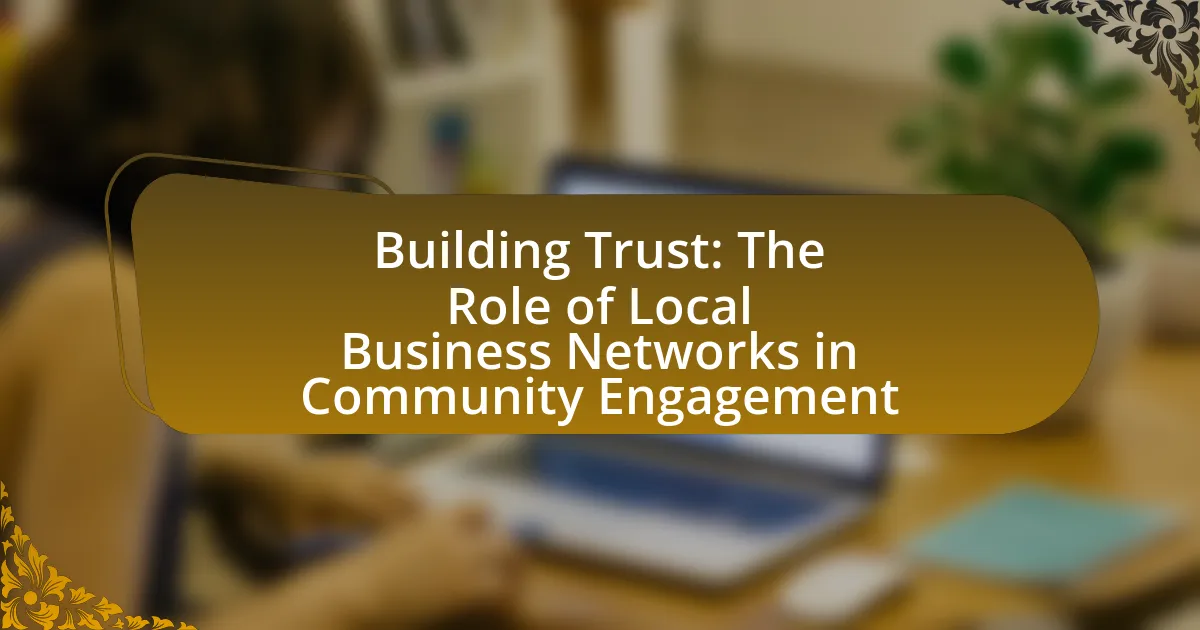Strategic partnerships for local businesses are collaborative agreements designed to achieve mutual benefits such as increased market reach, shared resources, and enhanced customer offerings. This article explores the various forms of partnerships, including joint marketing initiatives and co-hosting events, and highlights their advantages, such as improved competitiveness and innovation. It also discusses how businesses can identify potential partners, the importance of alignment in values and goals, and best practices for building successful collaborations. Additionally, the article addresses common challenges in partnerships and offers practical tips for maintaining strong communication and accountability, ultimately emphasizing the role of strategic partnerships in driving growth for local businesses.

What are Strategic Partnerships for Local Businesses?
Strategic partnerships for local businesses are collaborative agreements between two or more businesses aimed at achieving mutual benefits, such as increased market reach, shared resources, and enhanced customer offerings. These partnerships can take various forms, including joint marketing initiatives, co-hosting events, or sharing physical spaces, which allow businesses to leverage each other’s strengths and customer bases. For instance, a local coffee shop partnering with a bakery can attract more customers by offering combined promotions, thereby increasing sales for both entities. Such collaborations are essential for local businesses to compete effectively in their markets, as they can pool resources and expertise to create a more compelling value proposition for customers.
How do strategic partnerships benefit local businesses?
Strategic partnerships benefit local businesses by enhancing their market reach and resource sharing. These collaborations allow businesses to combine strengths, such as expertise, customer bases, and technologies, leading to increased competitiveness. For instance, a local restaurant partnering with a nearby farm can source fresh ingredients while promoting the farm, attracting customers interested in local produce. According to a study by the Harvard Business Review, companies that engage in strategic partnerships can see revenue growth rates that are 20% higher than those that do not. This demonstrates that strategic partnerships not only foster innovation but also drive financial success for local businesses.
What are the key advantages of collaboration among local businesses?
Collaboration among local businesses leads to increased resource sharing, which enhances operational efficiency. When businesses work together, they can pool resources such as marketing efforts, technology, and expertise, resulting in cost savings and improved service offerings. For instance, a study by the U.S. Small Business Administration found that businesses that collaborate can increase their market reach by up to 30%, demonstrating the tangible benefits of joint efforts. Additionally, collaboration fosters innovation, as diverse perspectives contribute to creative problem-solving and new product development. This synergy not only strengthens individual businesses but also boosts the local economy by creating a more vibrant and competitive marketplace.
How can partnerships enhance customer reach and engagement?
Partnerships enhance customer reach and engagement by leveraging combined resources and networks to access a broader audience. When businesses collaborate, they can share marketing channels, cross-promote products or services, and tap into each other’s customer bases, which increases visibility and engagement. For instance, a study by the Harvard Business Review found that companies that engage in strategic partnerships can see a 20% increase in customer acquisition due to shared marketing efforts and enhanced brand credibility. This collaborative approach not only attracts new customers but also fosters deeper engagement through shared experiences and offerings, ultimately driving mutual growth.
What types of partnerships can local businesses form?
Local businesses can form several types of partnerships, including strategic alliances, joint ventures, co-marketing partnerships, and supplier partnerships. Strategic alliances involve collaboration between businesses to achieve mutual goals while maintaining their independence. Joint ventures are more formal arrangements where two or more businesses create a new entity to pursue a specific project or goal, sharing resources and risks. Co-marketing partnerships allow businesses to promote each other’s products or services, leveraging each other’s customer bases for increased visibility. Supplier partnerships focus on building strong relationships with suppliers to ensure quality and reliability in the supply chain. These partnership types enable local businesses to enhance their market presence, share resources, and drive growth collectively.
What are the differences between formal and informal partnerships?
Formal partnerships are legally binding agreements between parties that outline specific roles, responsibilities, and terms of collaboration, while informal partnerships are more flexible, often based on mutual understanding and trust without legal documentation. Formal partnerships typically require registration, adherence to regulatory standards, and detailed contracts, which provide clear guidelines and accountability. In contrast, informal partnerships rely on verbal agreements or simple arrangements, allowing for adaptability and quick decision-making but lacking the legal protections and structure of formal partnerships. This distinction is crucial for businesses to understand when considering collaboration strategies, as formal partnerships can offer stability and legal recourse, whereas informal partnerships can foster innovation and responsiveness.
How can local businesses leverage joint marketing initiatives?
Local businesses can leverage joint marketing initiatives by collaborating on shared advertising campaigns, which allows them to pool resources and reach a broader audience. For instance, two or more businesses can co-host events or promotions, thereby increasing foot traffic and customer engagement for all parties involved. According to a study by the American Marketing Association, businesses that engage in joint marketing can see up to a 30% increase in customer acquisition compared to solo efforts. This collaborative approach not only reduces individual marketing costs but also enhances brand visibility and credibility through association with complementary businesses.

How can Local Businesses Identify Potential Partners?
Local businesses can identify potential partners by conducting market research to analyze complementary services and shared target audiences. This involves assessing local competitors, industry trends, and community needs to find businesses that align with their values and objectives. For instance, a local coffee shop may partner with a bakery to offer combined products, enhancing customer experience and expanding reach. Additionally, networking at local events and joining business associations can facilitate connections with potential partners, as these platforms often foster collaboration opportunities.
What criteria should businesses consider when selecting partners?
Businesses should consider alignment of goals, complementary strengths, and cultural fit when selecting partners. Alignment of goals ensures that both parties share a common vision and objectives, which is crucial for long-term collaboration. Complementary strengths allow businesses to leverage each other’s capabilities, enhancing overall performance and innovation. Cultural fit is essential as it fosters effective communication and collaboration, reducing the risk of conflicts. Research indicates that partnerships with aligned values and complementary skills are more likely to succeed, as evidenced by a study from the Harvard Business Review, which found that 70% of partnerships fail due to misalignment in these areas.
How important is alignment in values and goals for partnerships?
Alignment in values and goals is crucial for partnerships, as it directly influences collaboration effectiveness and long-term success. When partners share similar values and objectives, they are more likely to communicate openly, resolve conflicts amicably, and work towards common goals. Research indicates that organizations with aligned values experience higher levels of trust and commitment, leading to improved performance outcomes. For instance, a study by the Harvard Business Review found that companies with aligned missions and values reported a 30% increase in partnership satisfaction and effectiveness. This evidence underscores the importance of alignment in fostering successful and sustainable partnerships.
What role does complementary expertise play in partnership selection?
Complementary expertise plays a crucial role in partnership selection by enhancing the overall capabilities and resources of the collaborating entities. When businesses choose partners with different but complementary skills, they can leverage each other’s strengths to fill gaps in knowledge, technology, or market access. For instance, a technology firm partnering with a marketing agency can combine innovative product development with effective promotional strategies, leading to improved market performance. This synergy not only fosters innovation but also increases competitiveness, as evidenced by studies showing that partnerships with diverse expertise can lead to higher success rates in achieving strategic goals.
How can local businesses approach potential partners?
Local businesses can approach potential partners by identifying shared goals and values, then initiating contact through networking events or direct outreach. This method fosters a collaborative environment where both parties can discuss mutual benefits. Research indicates that 70% of partnerships succeed when both entities align on objectives and communicate effectively, highlighting the importance of strategic alignment in partnership formation.
What strategies can be used to initiate partnership discussions?
To initiate partnership discussions, businesses can employ strategies such as identifying common goals, leveraging existing networks, and conducting thorough research on potential partners. Identifying common goals ensures that both parties have aligned interests, which is crucial for a successful partnership. Leveraging existing networks allows businesses to tap into referrals and introductions, increasing the likelihood of meaningful connections. Conducting thorough research on potential partners helps in understanding their strengths, weaknesses, and market positioning, which can facilitate more informed and productive discussions. These strategies are supported by the fact that successful partnerships often stem from shared objectives and mutual understanding, as evidenced by numerous case studies in collaborative business ventures.
How can businesses effectively communicate their value proposition?
Businesses can effectively communicate their value proposition by clearly articulating the unique benefits and solutions they offer to their target audience. This involves identifying the specific needs of customers and aligning the value proposition with those needs, ensuring that messaging is concise and focused on the advantages that differentiate the business from competitors. For instance, a study by the Harvard Business Review found that companies with a well-defined value proposition are 60% more likely to achieve higher customer retention rates. By utilizing clear language, visual aids, and consistent messaging across all platforms, businesses can enhance understanding and engagement, ultimately fostering stronger connections with their audience.

What are the Best Practices for Building Successful Partnerships?
The best practices for building successful partnerships include establishing clear communication, defining mutual goals, and fostering trust. Clear communication ensures that all parties understand expectations and responsibilities, which is essential for collaboration. Defining mutual goals aligns the interests of both partners, creating a shared vision that drives the partnership forward. Fostering trust through transparency and reliability strengthens the relationship, making it more resilient to challenges. Research indicates that partnerships with strong communication and trust are 30% more likely to achieve their objectives, highlighting the importance of these practices in successful collaborations.
How can local businesses establish clear partnership goals?
Local businesses can establish clear partnership goals by conducting a thorough needs assessment and aligning their objectives with potential partners. This involves identifying specific outcomes they wish to achieve, such as increased customer reach or shared resources, and ensuring that these goals are mutually beneficial. Research indicates that 70% of partnerships fail due to unclear objectives, highlighting the importance of setting precise, measurable goals from the outset. By utilizing tools like SMART criteria (Specific, Measurable, Achievable, Relevant, Time-bound), businesses can create a structured framework for their partnership goals, ensuring clarity and focus throughout the collaboration process.
What metrics should be used to measure partnership success?
To measure partnership success, key metrics include revenue growth, customer acquisition rates, and engagement levels. Revenue growth indicates the financial impact of the partnership, while customer acquisition rates reflect the effectiveness of joint marketing efforts. Engagement levels, such as shared projects or co-branded initiatives, demonstrate the depth of collaboration. According to a study by the Harvard Business Review, successful partnerships often see a 20-30% increase in revenue due to effective collaboration, highlighting the importance of these metrics in assessing partnership outcomes.
How can businesses ensure mutual accountability in partnerships?
Businesses can ensure mutual accountability in partnerships by establishing clear roles, responsibilities, and performance metrics from the outset. This clarity fosters transparency and trust, which are essential for effective collaboration. For instance, defining specific deliverables and timelines allows both parties to measure progress and hold each other accountable. Research indicates that partnerships with well-defined agreements experience a 30% increase in project success rates, highlighting the importance of accountability structures. Regular communication and feedback mechanisms further reinforce this accountability, enabling businesses to address issues proactively and maintain alignment towards shared goals.
What are common challenges in strategic partnerships?
Common challenges in strategic partnerships include misaligned goals, communication barriers, and differing organizational cultures. Misaligned goals can lead to conflicts in priorities, making it difficult for partners to work towards a common objective. Communication barriers often arise from differences in terminology or communication styles, which can hinder effective collaboration. Additionally, differing organizational cultures can create friction, as partners may have contrasting values and operational practices. These challenges can impede the success of partnerships, as evidenced by studies indicating that 70% of strategic alliances fail due to such issues.
How can businesses address conflicts that arise in partnerships?
Businesses can address conflicts that arise in partnerships by implementing clear communication strategies and establishing conflict resolution protocols. Effective communication ensures that all parties understand each other’s perspectives, which can prevent misunderstandings that lead to conflicts. Additionally, having predefined conflict resolution protocols, such as mediation or negotiation processes, allows businesses to address issues systematically and constructively. Research indicates that organizations with strong communication practices experience 25% fewer conflicts, highlighting the importance of these strategies in maintaining healthy partnerships.
What strategies can help maintain strong communication between partners?
Effective strategies to maintain strong communication between partners include regular check-ins, active listening, and clear goal-setting. Regular check-ins foster ongoing dialogue, allowing partners to address concerns and share updates, which is essential for alignment. Active listening ensures that each partner feels heard and valued, promoting trust and understanding. Clear goal-setting provides a shared vision and measurable objectives, which helps partners stay focused and accountable. Research indicates that organizations with strong communication practices experience 25% higher productivity, highlighting the importance of these strategies in fostering successful partnerships.
What practical tips can local businesses implement for successful collaboration?
Local businesses can implement several practical tips for successful collaboration, including establishing clear communication channels, defining mutual goals, and leveraging each other’s strengths. Clear communication ensures that all parties are aligned and can address issues promptly, while defining mutual goals fosters a shared vision that drives collaboration. Additionally, leveraging each other’s strengths allows businesses to complement one another, enhancing overall effectiveness. For instance, a study by the Harvard Business Review found that companies that prioritize collaboration can increase productivity by up to 25%.








































